Communications
(or how to railroad without a radio)
April 22, 2002
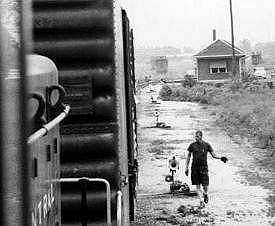 Before radios, each train was like an island. Once you had permission to leave a point, the crew operated as a unit, separate from other trains except by train orders or signal indication. If trouble developed it was taken care of on the spot. Whatever was necessary to fix the problem was done. If a telephone was near, the open block station was called and the operator notified the dispatcher of the problem.
Before radios, each train was like an island. Once you had permission to leave a point, the crew operated as a unit, separate from other trains except by train orders or signal indication. If trouble developed it was taken care of on the spot. Whatever was necessary to fix the problem was done. If a telephone was near, the open block station was called and the operator notified the dispatcher of the problem.
To get to the point just related we will start at the beginning. When railroading started the crew could speak to each other about train operation. As the trains grew in length it became apparent that the ground man was going to do a lot of walking to speak instructions. Hand signals were the next move. This worked fine and when trains
started running at night, day signals had to be converted to a light, to give the same indication as the day indication.
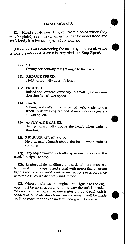 The page to the left is from the Conrail 1979 Rule Book and not the NYC Rule Book that Maurice worked under. It is included as a sample only and does not follow the text exactly.
The page to the left is from the Conrail 1979 Rule Book and not the NYC Rule Book that Maurice worked under. It is included as a sample only and does not follow the text exactly.
They finally had six standard hand and light signals. Of course there are many signals besides these that the men on each railroad developed for their particular needs. For those without a book of rules, I will try to describe them.
Rule 12a, stop.
[Swung horizontally at right angle to the track.]
This is sometimes called a swingdown. The reason for that name is the brakeman is going from a reduced speed hand signal, (or the word easy if the fireman was relaying the signal to the engineer), to the hand stop signal.
Rule 12b, reduced speed.
[Held horizontally at arms length.]
This signal is used previous to the stop signal 12a. It also is used if the engine was shoving cars and the brakeman wanted to slow down approaching a road crossing or any reason to slow the movement down, usually followed by a proceed signal if the way was clear. As already quoted, this was usually called out as easy on the NYC at Elkhart, Anderson, Indianapolis and Cincinnati, in this general area. Occasionally you would hear, hold up, but this was rare.
The easy signal was given based on the cuts speed and distance from the car or place you wanted to stop. A few brakemen could judge speed and distance as a fine art. If you followed their signals you could couple to a car or another cut with a passenger train coupling (that means gently.) The Elkhart yard men gave this easy signal differently than any other trainmen that I worked with. Their method was at about two cars from a coupling or a stop, they would raise their lantern in almost a panic move to the easy position and when they heard or felt, by slack action, the engineer acknowledge the signal, they would drop their hand or lantern the same as going to a stop signal.
 This doesn't sound like a hard thing to become used to, but it takes a lot of getting used to. When they dropped the hand or lantern they did not want to stop. When you were within about a car length they would
give an easy and then a stop signal in the normal way. I know of one engineer who broke the brake handle off trying to stop with this signal.
This doesn't sound like a hard thing to become used to, but it takes a lot of getting used to. When they dropped the hand or lantern they did not want to stop. When you were within about a car length they would
give an easy and then a stop signal in the normal way. I know of one engineer who broke the brake handle off trying to stop with this signal.
Rule 12c, proceed.
[Raised and lowered vertically. A smaller, slower motion signals a slower speed.]
I call this the bye bye signal. Giving this was like waving goodbye to someone. The farther you were from the engine the larger this or any signal had to be. If you were at the rear of the engine it meant go ahead, in relation to the direction the engine was headed. If you were in front and you waved bye bye, that meant come ahead per the direction of the engine. When we first started using GP-7, GP-9, diesels, some wanted to use the train direction as forward or backward but this would not work. On the NYC the long hood was forward on the GP-7, 9. All diesel units were marked F-1 and F-2 along the front or back of the frame of the locomotive. If you had more than one unit in the consist, the front or back of the unit the engineer was working from was what determined forward or backward. F-1 was the leading end.
Rule 12d, back.
[Swung vertically in a circle, at right angle to the track. A decreasing arc and slower motion signals a slower speed.]
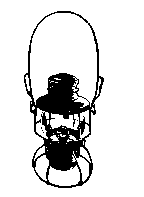 Back was like proceed. It was determined by forward or backward on the unit where the engineer was located. This signal was given in a circle, small close, larger far away. If the brakeman was some distance away, say sixty car lengths, in daylight he would pick up a piece of scrap paper, if in car shadows and give a signal. To make a move a short distance, the signal would be given in a large circle but slowly. This determined speed and distance to the move. Back was like proceed. It was determined by forward or backward on the unit where the engineer was located. This signal was given in a circle, small close, larger far away. If the brakeman was some distance away, say sixty car lengths, in daylight he would pick up a piece of scrap paper, if in car shadows and give a signal. To make a move a short distance, the signal would be given in a large circle but slowly. This determined speed and distance to the move.
A circle at a speed between slow and fast would naturally be for a normal switching speed move. Each brakeman's signals were like a written signature. You could tell who was giving the signal by the way the signal was given.
Rule e, not used now because the length of trains voided its use. It was a train parted signal. This was not one of the six signals mentioned at the start of the article.
Rule f, apply airbrakes.
[Swung horizontally above the head, when train is standing.]
It is used in air brake tests. The hand or light swung horizontally above the head tells the engineer to apply the brakes. This is in the yards or on the road.
Rule g, release air brakes.
[Held at arm's length above the head, when train is standing.]
Notice this is a small g. The hand or light held above the head tells the engineer to release the brakes.
Rule h. I will have to make it seven rules instead of six. Rule h states, any object waved violently on or near the track is a signal to stop. Also included (as hand signals) is the proper use of torpedos and fusee.
There were many variations of these signals. Most of the time, the stop signal was given as described in the text. Sometimes the brakeman might misjudge speed or distance. As he realizes this he will give an excited stop. If it is going to be a real hard coupling, the trainman would swing down, leap from the car and give a panic stop with both arms. In the engine cab, you braced yourself and told the fireman to "Hang on, he is trying to fly." This is when the brakeman looked like he was flapping his arms like a bird trying to fly.
You adapt to each crew's way of giving signals. Hand signals were part of the fireman's training. One crew gave what we call glove signals, when working with a fireman with little experience, A glove signal is a signal given by the brakeman while holding a glove between his thumb and trigger finger. Holding` the glove in this manner was only used by this crew. These signals were given with wrist action more than arm movement and at not more than 10 or 12 cars away.
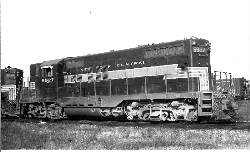 I had the new fireman stand behind me and watch the trainman give signals. After watching two or three moves, the fireman began running the engine. I told him to watch the trainmen closely as they gave signals. The pin man,
(the trainman that lifts the cut lever between cars when switching cars on the switching lead) gives the kick signal. We charge down the lead and just before passing by the conductor, he gives a stop signal, holding the glove by its thumb between his thumb and trigger finger. I asked the fireman if they gave a back up signal? He said, "No." I asked this question because, standing behind him, I saw the conductor give a backup signal as we passed by him.
I had the new fireman stand behind me and watch the trainman give signals. After watching two or three moves, the fireman began running the engine. I told him to watch the trainmen closely as they gave signals. The pin man,
(the trainman that lifts the cut lever between cars when switching cars on the switching lead) gives the kick signal. We charge down the lead and just before passing by the conductor, he gives a stop signal, holding the glove by its thumb between his thumb and trigger finger. I asked the fireman if they gave a back up signal? He said, "No." I asked this question because, standing behind him, I saw the conductor give a backup signal as we passed by him.
"Ask them what they want to do. They gave a back up signal." Now the point of this is you keep your eye on the man giving the signal, in this case the conductor. Making another kick down the lead, I instructed the fireman to never take his eye from the conductor. He was watching the conductor and just as the conductor passed under the engine cab, he gave a back up signal.
This is why you must always watch for signals. A missed signal could mean an accident or injury.
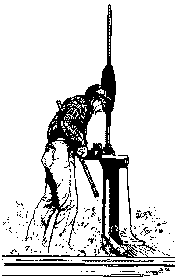 I guess I should explain a kick. On a switching lead you naturally are kicking cars during your tour of duty. Imagine giving a kick with your leg. In switching this means a quick start to a speed determined by the
trainmen that will let the car or cars enter the correct track and then stop the engine. I suppose a book could be produced with just the different hand signals used on the different railroads.
I guess I should explain a kick. On a switching lead you naturally are kicking cars during your tour of duty. Imagine giving a kick with your leg. In switching this means a quick start to a speed determined by the
trainmen that will let the car or cars enter the correct track and then stop the engine. I suppose a book could be produced with just the different hand signals used on the different railroads.
We had a conductor at Marion Indiana that would give you as many as ten moves that would be made, by giving the engine crew hand signals. As an example; the conductor would tell the engineer to back down the main, shove in the siding, come out of the siding down the main back in the siding, get the cars from the siding, shove in Anaconda, pick up the loads and respot the empties. All of these moves were given to the engineer by hand signals. The signals were given all at one time as if he was talking to you.
While I was still working, the radio traffic at Avon Indiana would be very heavy. We had two channels and they would be so busy that sometimes we would have to wait until they slowed down to be able to talk to the dispatcher or yardmaster to make our moves. After we had permission and the radio traffic was still heavy, I would get the trainman's attention and we would work by hand signals until the radio traffic slowed down. I understand that today some railroads won't allow hand signals except in dire emergency.
 Hand signals were basically safer than radio and less time consuming in busy radio conditions. I know this is going to spark an argument, but remember what I said about each crew being an island. With hand signals
each crew was isolated from other crews. With the radio all crews are in a mix. When radio traffic is low things are okay but as traffic increases, safety becomes a problem to deal with.
Hand signals were basically safer than radio and less time consuming in busy radio conditions. I know this is going to spark an argument, but remember what I said about each crew being an island. With hand signals
each crew was isolated from other crews. With the radio all crews are in a mix. When radio traffic is low things are okay but as traffic increases, safety becomes a problem to deal with.
As I started to write this, I thought, "Would it be interesting to anyone?" About this time a friend asked me how we communicated before radios. I hope this helps the younger generation understand why there were four
and five men on the crews and a caboose on the end of the train.
Maurice Lewman
Maurice worked the Michigan Division from 1947-1981. He then worked on the Bee Line from 1981-1992. From 1947 until august 1950, he worked on the section at Shirley and Markleville. In 1950 he started firing on steam and then on through the diesels. Maurice said, "I had the pleasure of working with C. C. Staley and Ron Buser many times."
Photo Credits:
South Anderson Switching 1965 photo by Maurice Lewman
6829 in Marion Indiana 0-6-0 6820 - B10t - Marion IN - 8/6/39 - {Gary Overfield Collection} Courtesy of Geroge Elwood's Fallen Flag Railroad Photos web site.
NYC 5927 at South Anderson GP9 EMD 1750HP NYC Class DRS-9B, Built 4/56,10/29/1960 - Bob Bruns Collection
| 
 Before radios, each train was like an island. Once you had permission to leave a point, the crew operated as a unit, separate from other trains except by train orders or signal indication. If trouble developed it was taken care of on the spot. Whatever was necessary to fix the problem was done. If a telephone was near, the open block station was called and the operator notified the dispatcher of the problem.
Before radios, each train was like an island. Once you had permission to leave a point, the crew operated as a unit, separate from other trains except by train orders or signal indication. If trouble developed it was taken care of on the spot. Whatever was necessary to fix the problem was done. If a telephone was near, the open block station was called and the operator notified the dispatcher of the problem.

 This doesn't sound like a hard thing to become used to, but it takes a lot of getting used to. When they dropped the hand or lantern they did not want to stop. When you were within about a car length they would
give an easy and then a stop signal in the normal way. I know of one engineer who broke the brake handle off trying to stop with this signal.
This doesn't sound like a hard thing to become used to, but it takes a lot of getting used to. When they dropped the hand or lantern they did not want to stop. When you were within about a car length they would
give an easy and then a stop signal in the normal way. I know of one engineer who broke the brake handle off trying to stop with this signal.
 Back was like proceed. It was determined by forward or backward on the unit where the engineer was located. This signal was given in a circle, small close, larger far away. If the brakeman was some distance away, say sixty car lengths, in daylight he would pick up a piece of scrap paper, if in car shadows and give a signal. To make a move a short distance, the signal would be given in a large circle but slowly. This determined speed and distance to the move.
Back was like proceed. It was determined by forward or backward on the unit where the engineer was located. This signal was given in a circle, small close, larger far away. If the brakeman was some distance away, say sixty car lengths, in daylight he would pick up a piece of scrap paper, if in car shadows and give a signal. To make a move a short distance, the signal would be given in a large circle but slowly. This determined speed and distance to the move.
 I had the new fireman stand behind me and watch the trainman give signals. After watching two or three moves, the fireman began running the engine. I told him to watch the trainmen closely as they gave signals. The pin man,
(the trainman that lifts the cut lever between cars when switching cars on the switching lead) gives the kick signal. We charge down the lead and just before passing by the conductor, he gives a stop signal, holding the glove by its thumb between his thumb and trigger finger. I asked the fireman if they gave a back up signal? He said, "No." I asked this question because, standing behind him, I saw the conductor give a backup signal as we passed by him.
I had the new fireman stand behind me and watch the trainman give signals. After watching two or three moves, the fireman began running the engine. I told him to watch the trainmen closely as they gave signals. The pin man,
(the trainman that lifts the cut lever between cars when switching cars on the switching lead) gives the kick signal. We charge down the lead and just before passing by the conductor, he gives a stop signal, holding the glove by its thumb between his thumb and trigger finger. I asked the fireman if they gave a back up signal? He said, "No." I asked this question because, standing behind him, I saw the conductor give a backup signal as we passed by him.
 I guess I should explain a kick. On a switching lead you naturally are kicking cars during your tour of duty. Imagine giving a kick with your leg. In switching this means a quick start to a speed determined by the
trainmen that will let the car or cars enter the correct track and then stop the engine. I suppose a book could be produced with just the different hand signals used on the different railroads.
I guess I should explain a kick. On a switching lead you naturally are kicking cars during your tour of duty. Imagine giving a kick with your leg. In switching this means a quick start to a speed determined by the
trainmen that will let the car or cars enter the correct track and then stop the engine. I suppose a book could be produced with just the different hand signals used on the different railroads.
 Hand signals were basically safer than radio and less time consuming in busy radio conditions. I know this is going to spark an argument, but remember what I said about each crew being an island. With hand signals
each crew was isolated from other crews. With the radio all crews are in a mix. When radio traffic is low things are okay but as traffic increases, safety becomes a problem to deal with.
Hand signals were basically safer than radio and less time consuming in busy radio conditions. I know this is going to spark an argument, but remember what I said about each crew being an island. With hand signals
each crew was isolated from other crews. With the radio all crews are in a mix. When radio traffic is low things are okay but as traffic increases, safety becomes a problem to deal with.